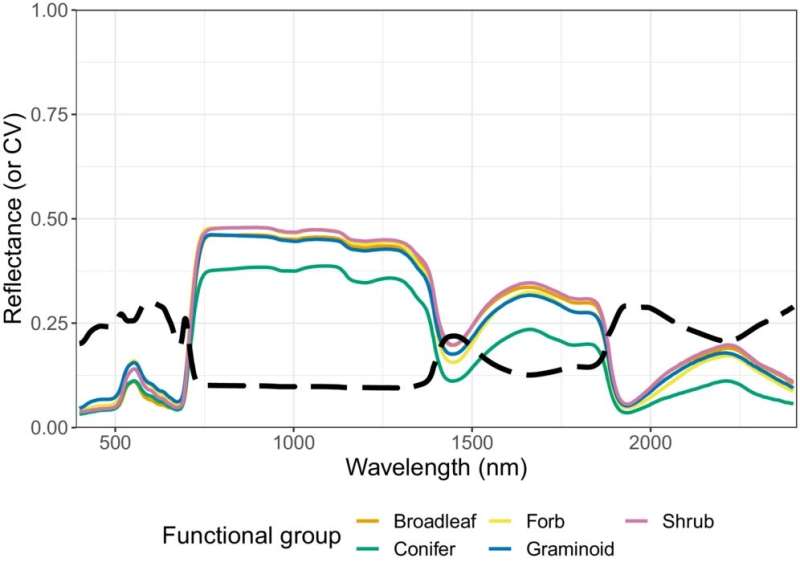This article has been reviewed according to Science X's editorial process and policies. Editors have highlighted the following attributes while ensuring the content's credibility:
fact-checked
peer-reviewed publication
trusted source
proofread
New statistical models speed up process of estimating leaf traits across functional groups

To understand how plants respond to and influence their environments, ecologists often use a series of standardized measurements called functional traits. For example, a plant's capacity to do photosynthesis is influenced by traits like leaf nitrogen concentration.
But measuring such traits can be very time-consuming, which limits how much information ecologists can acquire.
Now a research team at Université de Montréal has developed a way to bypass these limits with new statistical models that estimate leaf traits rapidly across many plants from a broad range of landscapes.
In a study published today in New Phytologist, the researchers discuss how reflectance spectra—measurements of light's reflectance across hundreds of wavelengths, well beyond what the human eye can see—can be used to estimate traits quickly and non-destructively, either leaf by leaf or remotely over entire landscapes using sophisticated cameras mounted on aircraft or satellites.
"With new satellite missions like EnMAP and PRISMA, we're now able to measure the spectral reflectance of vegetation for vast areas of the globe from space," said senior author Etienne Laliberté, an UdeM biology professor. "Our study shows how it'll be possible to translate these spectral data into ecologically relevant information about how plants function."
A model for each trait
Estimating functional traits from reflectance spectra requires having a model for each trait, but suitable models for most traits are either unavailable or were developed to work only on a small and unrepresentative fraction of Earth's vast plant diversity.
In their paper, the UdeM team built and validated a set of trait estimation models using a dataset of reflectance spectra and nearly two dozen traits measured on almost 2,000 leaf samples collected by the Canadian Airborne Biodiversity Observatory that include more than 100 species of trees, shrubs, grasses, and other herbaceous plants.
"The samples span a number of ecosystems, including ones like bogs and oak savannas that are threatened by climate and land use change," said Shan Kothari, a postdoctoral researcher in Laliberté's lab when the research was conducted. "We built the models using a statistical technique called partial least-squares regression, and tested their performance both within the CABO data set and on external data sets collected by other scientists."
Quite accurate results
The results were in many cases quite accurate. The UdeM models captured more than 80 percent of the variation in many important leaf functional traits, including leaf mass per area, cellulose concentration, and water content. Among other traits, the accuracy of predictions varied widely; traits like pigments and major nutrients were predicted with intermediate performance, while many of the micronutrients could only be predicted very poorly.
"Any plant ecologist working in the field knows how time-consuming it is to measure lots of functional traits, which is a major limitation in discovering how plant communities work," said Kothari. "We hope reflectance spectroscopy can alleviate this burden and allow ecologists to understand the interactions between plants and their environment in greater depth."
Added co-researcher Rosalie Beauchamp-Rioux: "Reflectance spectra are an invaluable source of information—but first you need to be able to decipher them. Our study should help others to develop techniques that use remote sensing of plants to better understand the workings of ecosystems, and thereby better manage and conserve biodiversity."
More general models
Although the UdeM dataset is mostly limited to Canadian plants, the researchers say continued data collection and synthesis may one day allow researchers to develop even more general models—ones that researchers could use to estimate the traits of any plant without needing to perform extensive validation.
"To train such models would require trait and spectral data from a wider variety of biomes, including tropical, desert, and tundra ecosystems," Laliberté said. "This would make it much easier for ecologists to measure plant function quickly and at greater scale, allowing us to detect how plant communities are responding to global change."
He added, "The recent COP15 conference in Montreal has drawn the world's eyes to the global loss of biodiversity, of which functional diversity is one aspect. We hope our models enable a better understanding of the loss or resilience of functional diversity in Canada's plant communities—and that that will help answer biological questions anywhere on Earth."
More information: Shan Kothari et al, Predicting leaf traits across functional groups using reflectance spectroscopy, New Phytologist (2023). DOI: 10.1111/nph.18713
Journal information: New Phytologist
Provided by University of Montreal




















